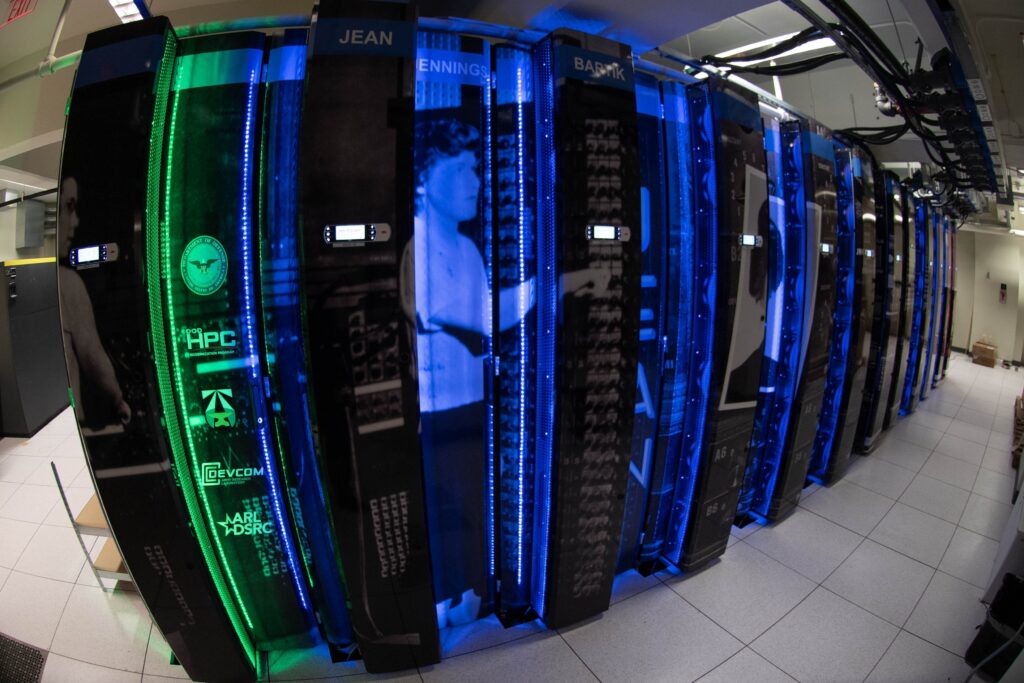
A Defense Innovation Unit initiative aims to connect the Pentagon’s powerful computers with cloud services, potentially offering swift, real-time data processing to military personnel globally. Currently, the Pentagon primarily uses physical computers for this purpose, which are costly to acquire and upkeep. Through this DIU project, Rescale and Parallel Works have shown they can deliver these computing capabilities via the cloud, eliminating the need for users to have direct access to physical hardware.
High-performance computing provides a technological edge for Department of Defense projects by minimizing expenses associated with costly and destructive live experiments and prototype demonstrations. This technology empowers researchers to tackle the most challenging military operational issues using advanced computational methods. Enhancing these capabilities allows researchers to utilize various aspects of applications, enabling them to design and enhance systems more rapidly, thereby bolstering national security.
Our analysis indicates that the military cloud computing sector is expected to experience significant growth. Valued at approximately USD 9.3 billion in 2024, this market is forecasted to nearly double, reaching an estimated USD 18.3 billion by 2030.
The military’s use of cloud-based supercomputing services like Infrastructure as a Service (IaaS), Platform as a Service (PaaS), and Software as a Service (SaaS) is multifaceted and strategically important. This is how these services are utilized:
- Infrastructure as a Service (IaaS):
- Rapid Deployment: The military can quickly set up and scale computational resources for time-sensitive operations or simulations without the need for physical hardware installation.
- Global Access: IaaS allows for distributed computing power, enabling personnel in various locations to access high-performance computing resources.
- Cost Efficiency: By using IaaS, the military can avoid the high costs of maintaining and upgrading physical supercomputers at multiple locations.
- Disaster Recovery: Cloud-based infrastructure provides robust backup and recovery options, crucial for maintaining operational continuity in case of physical disasters or attacks.
2. Platform as a Service (PaaS):
- Custom Application Development: PaaS enables military developers to create, test, and deploy custom applications tailored to specific military needs without managing the underlying infrastructure.
- Collaborative Development: Multiple teams can work on the same platform, facilitating joint projects between different branches or even allied forces.
- AI and Machine Learning Integration: PaaS often includes tools for AI and machine learning, which the military can use for data analysis, predictive maintenance, and autonomous systems development.
- Secure Environment: PaaS provides a controlled environment for developing sensitive applications, ensuring security protocols are consistently applied.
3. Software as a Service (SaaS):
- Standardization: SaaS allows the military to standardize software across different units and locations, ensuring consistency in operations and training.
- Real-time Updates: Critical software can be updated instantaneously across all users, ensuring that all personnel have access to the latest features and security patches.
- Specialized Applications: The military can access specialized software for tasks like logistics management, personnel tracking, or battlefield simulations without the need for individual installations.
- Data Analytics: SaaS solutions often include powerful analytics tools, allowing the military to process and analyze large datasets for intelligence purposes.
Then there are cross-cutting benefits:
- Enhanced Security: Cloud providers often have robust security measures that can complement military cybersecurity efforts.
- Interoperability: Cloud services can facilitate better interoperability between different military branches and allied forces.
- Scalability: All these services allow for rapid scaling of resources based on operational needs, from peacetime to conflict situations.
- Energy Efficiency: By utilizing shared resources, the military can reduce its overall energy footprint compared to maintaining numerous physical data centers.
The military’s use of cloud-based super computing in these areas is sophisticated and multifaceted. It is used for:
- Data Storage and Management:
- Centralized Data Lakes: Cloud super computing allows the creation of vast, secure data repositories that can store petabytes of information from various sources (satellite imagery, sensor data, mission reports).
- Dynamic Data Classification: AI-driven systems can automatically classify and tag incoming data, ensuring proper security levels and accessibility.
- Global Data Synchronization: Ensures that up-to-date information is available across all theaters of operation, enhancing situational awareness.
2. Command and Control:
- Real-time Battlefield Visualization: Cloud super computing enables the processing of massive amounts of data to create dynamic, real-time 3D battlefield visualizations for commanders.
- Automated Resource Allocation: AI algorithms can suggest optimal resource deployment based on real-time battlefield conditions.
- Secure Communication Channels: Quantum encryption techniques, powered by cloud super computing, can provide un-hackable communication lines for critical command decisions.
3. Analytics and Intelligence:
- Pattern Recognition: Advanced machine learning algorithms can analyze vast datasets to identify subtle patterns indicative of enemy movements or intentions.
- Multi-source Intelligence Fusion: Cloud super computing can integrate and analyze data from HUMINT, SIGINT, OSINT, and other sources to provide comprehensive intelligence pictures.
- Predictive Threat Analysis: By processing historical and real-time data, systems can predict potential threats or areas of instability.
4. Collaboration and Information Sharing:
- Cross-domain Solutions: Cloud-based systems can facilitate secure information sharing between different security domains and allied forces.
- Virtual War Rooms: Cloud-powered collaborative environments allow for real-time strategy sessions with participants from multiple locations.
- Multilingual AI Translation: Real-time translation of communications and documents to facilitate collaboration with international partners.
5. Virtual Training and Simulation:
- Hyper-realistic Combat Simulations: Cloud super computing power enables the creation of complex, multi-variable combat scenarios for training.
- AI-powered Opponents: Trainees can face off against AI adversaries that learn and adapt to different strategies.
- Large-scale Joint Operations Training: Simulations of massive, multi-domain operations involving thousands of virtual and human participants.
6. Cybersecurity and Threat Intelligence:
- Real-time Threat Detection: Cloud-based systems can analyze network traffic across multiple domains to identify and respond to cyber threats instantly.
- AI-driven Cyber Counterattacks: Automated systems can deploy countermeasures against cyber attacks at machine speed.
- Quantum-resistant Encryption: Development and testing of encryption methods that can withstand attacks from future quantum computers.
7. Rapid Deployment and Scalability:
- On-demand Compute Power: Ability to rapidly scale up computing resources for time-sensitive operations or analysis.
- Edge Computing Integration: Seamless integration of cloud resources with tactical edge devices for forward-deployed units.
- Adaptive Network Optimization: AI-driven systems that can reconfigure network topologies to maintain communication in contested environments.
8. Predictive Analytics and Decision Support:
- Strategic Wargaming: Running millions of conflict scenarios to identify optimal strategies and potential adversary actions.
- Logistics Optimization: Predicting equipment failures and optimizing supply chains to ensure operational readiness.
- Personnel Management: Using AI to optimize force structure, training programs, and deployment schedules based on multiple factors including geopolitical forecasts.
These applications of cloud-based super computing are transforming military operations, enabling faster decision-making, enhancing situational awareness, and providing strategic advantages across multiple domains. The integration of AI and machine learning with cloud super computing is particularly pivotal, as it allows for processing and analyzing data at scales and speeds previously unattainable, potentially reshaping the nature of modern warfare.
The military’s extensive use of cloud-based super computing opens up numerous opportunities for startups. Potential areas where startups could innovate and provide value:
Specialized AI and Machine Learning Solutions:
- Startups could develop niche AI algorithms tailored for specific military applications, such as threat detection in unconventional warfare or predictive maintenance for specialized equipment.
- Opportunities exist in creating AI models that can operate effectively with limited data, crucial for classified or rare military scenarios.
Edge Computing for Tactical Environments:
- Innovative solutions for deploying cloud capabilities in austere or contested environments could be a significant opportunity.
- Startups might develop ruggedized, portable edge computing devices that can seamlessly integrate with cloud infrastructure.
Quantum-Safe Cryptography:
- As quantum computing threatens current encryption methods, startups focusing on quantum-resistant encryption for military communications and data storage could find a receptive market.
Virtual and Augmented Reality for Training:
- There’s potential for startups to create highly realistic VR/AR training scenarios that integrate with cloud-based data and AI for adaptive learning experiences.
- Haptic feedback systems and other immersive technologies could enhance the realism of virtual training.
Data Fusion and Visualization:
- Startups could develop innovative ways to combine and visualize data from multiple sources, enhancing situational awareness for commanders.
- Novel interfaces for interacting with complex datasets, perhaps using brain-computer interfaces or advanced gesture control, could be areas of interest.
Autonomous Systems Integration:
- Solutions for seamlessly integrating autonomous vehicles, drones, and robots with cloud-based command and control systems represent a significant opportunity.
- Startups might focus on developing AI for swarm coordination or human-machine teaming in military contexts.
Cybersecurity and Threat Intelligence:
- There’s a constant need for innovative cybersecurity solutions, particularly those that can detect and respond to threats in real-time across vast military networks.
- Startups might develop AI-driven systems for proactive threat hunting or automated cyber counterattacks.
Natural Language Processing for Intelligence:
- Advanced NLP tools for analyzing vast amounts of unstructured data from diverse sources (social media, intercepted communications, open-source intelligence) could be valuable.
- Multilingual AI capable of understanding context, sentiment, and cultural nuances in communication could be particularly useful for intelligence gathering.
Blockchain for Secure Supply Chain Management:
- Startups could leverage blockchain technology to create tamper-proof, transparent supply chain systems for military logistics.
- Energy-Efficient Computing: Innovative solutions for reducing the energy footprint of high-performance computing in military applications could be attractive, especially for deployed operations.
- Synthetic Data Generation: Startups could develop advanced algorithms for generating synthetic data to train AI systems, particularly useful when real data is scarce or classified.
- Human Performance Optimization: AI-driven systems for monitoring and enhancing soldier performance, integrating biometric data with cloud-based analytics, could be an emerging field.
- Quantum Computing Applications: As quantum computing matures, startups focusing on military applications of this technology, such as ultra-secure communications or complex simulations, could find opportunities.
- Cross-Domain Solutions: Innovative ways to securely share information between different security domains while maintaining strict access controls could be valuable.
- AI Ethics and Accountability: As the military increasingly relies on AI for decision-making, startups developing tools for ensuring AI transparency, explainability, and adherence to ethical guidelines could find a market.
These opportunities require not only technical innovation but also a deep understanding of military needs, security requirements, and the complex procurement processes involved in defense contracts. Startups in this space would need to navigate strict security protocols and potentially lengthy approval processes. However, for those that succeed, the military’s increasing reliance on advanced cloud-based super computing presents a significant and growing market.
